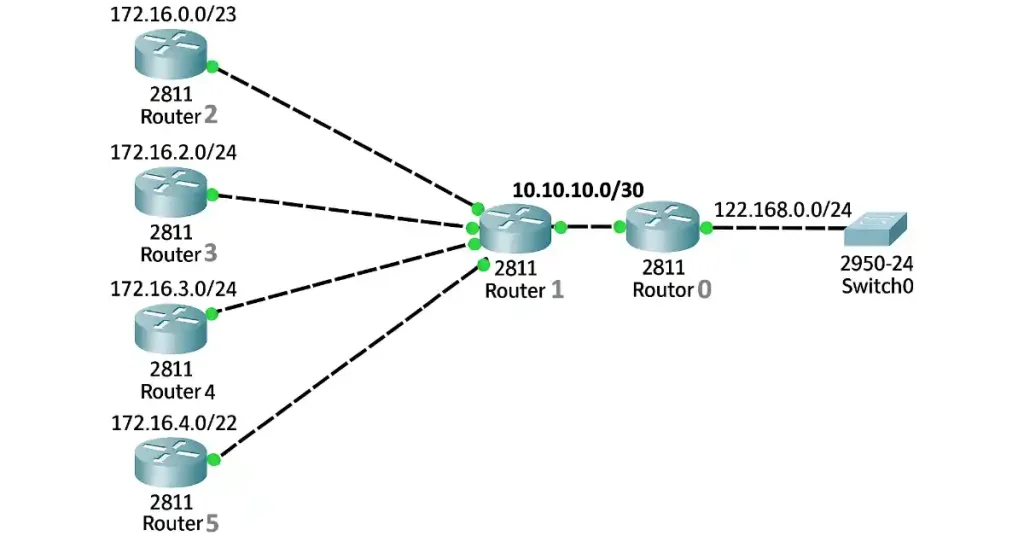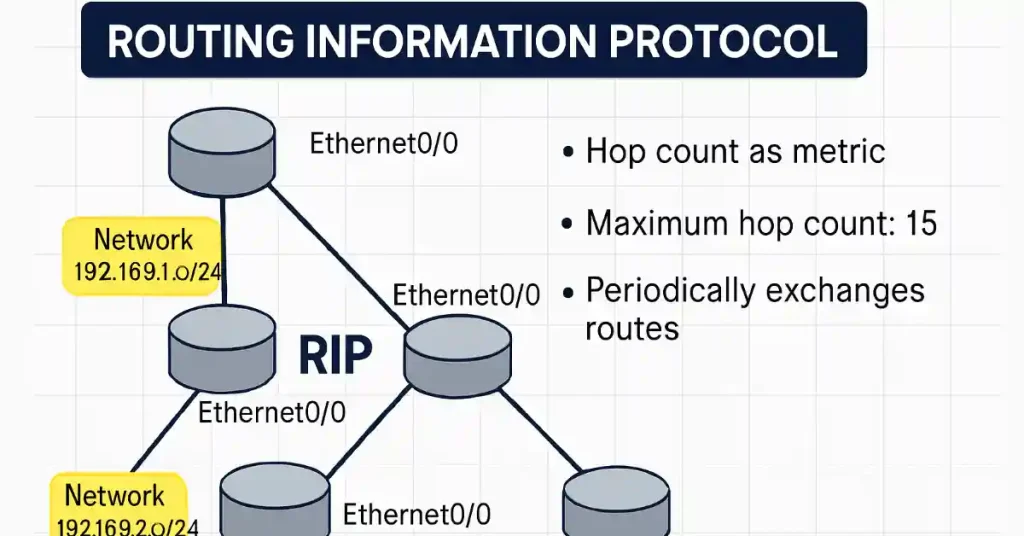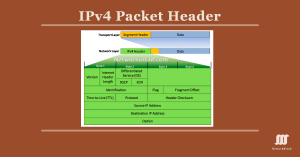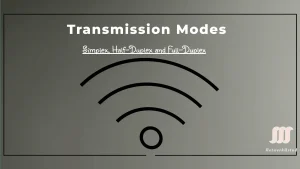Routing Information Protocol (RIP) is a dynamic routing protocol that defines a way for routers to connect different networks using the Internet Protocol (IP) to share information about how to route traffic among these other networks.
The Routing Information Protocol (RIP) uses hop count as a routing metric to determine the best path between the source and destination networks. Hop count is the number of routers along the path between the source and destination network. The path with the lowest hop count between the source and destination is considered the best and, therefore, placed in the routing table.
RIP exchanges routing updates periodically in a broadcast every 30 seconds. It broadcasts the entire routing table to its closest neighbours’ routers each time. The neighbours are the routers that are connected directly to this router.
The neighbours will pass the information on to their nearest neighbours, and so on. The routers always trust routing information received from neighbour routers. This is also known as routing on rumours. There are three versions of the routing information protocol: RIP Version 1, RIP Version 2, and RIPng.
In case of a router crash or a network connection disruption, the network discovers this because that router will not send an update to its neighbours. If the discontinued route remains for 180 seconds, the RIP router will drop that route.
RIP also prevents routing loops by limiting the hops allowed in a path from source to destination. The maximum hop count allowed for RIP is 15, and a hop count of 16 is considered network unreachable.
RIP is a distance-vector routing protocol with an AD value of 120. It works on the application layer of the OSI model. RIP uses port number 520.
The RIP cannot scale extensive and complex networks. It pushes its whole routing table every 30 seconds, so it cannot converge quickly. RIP is used only due to its simplicity. RIP is primarily not used in modern networking; it is only the foundation for networking students to understand routing.
RIP Configuration
This article explains how to configure the RIP Routing protocol in detail. RIP is a Distance Vector routing protocol. Learn how to enable router RIP configuration mode and configure Routing Information Protocol routing in a Cisco router with the example in Packet Tracer.
Routing Information Protocol Configuration Mode

The figure above shows the reference topology, including its IP addresses. In the topology, all routers are configured with basic management features, and all interfaces are configured and enabled.
No dynamic and static routes are configured; therefore, we cannot access the routers remotely. We can enable RIP protocol using the router rip command, as shown below.
- Router0(config)#router rip
- Router0(config-router)#
The command provides access to the router configuration mode, where the RIP routing settings are configured.
To eliminate and remove the RIP configuration, use the no router rip command in global configuration mode. This command immediately stops the RIP process and erases all existing RIP configurations. To display and check the router mode command, execute the question mark(?) command in router mode. To check the routing protocols, use the following command and see the output:-
Router#show ip protocol
Routing Protocol is "rip"
Sending updates every 30 seconds, next due in 21 seconds
Invalid after 180 seconds, hold down 180, flushed after 240
Outgoing update filter list for all interfaces is not set
Incoming update filter list for all interfaces is not set
Redistributing: rip
Default version control: send version 1, receive any version
Interface FastEthernet0/0
Sending version 1, receiving version 1
Sending multicast updates on 224.0.0.9
Receiving multicast updates from 224.0.0.9
RIP authentication key-chain: ripkey
RIP authentication mode is md5
Automatic network summarization is in effect
Maximum path: 4
Routing for Networks:
10.0.0.0
192.168.0.0
Passive Interface(s):
Routing Information Sources:
Gateway Distance Last Update
Distance: (default is 120)Key Output Elements Explained
| Section | Meaning |
|---|---|
| Routing Protocol is “rip” | RIP is the active protocol. |
| Sending updates every 30 seconds | RIP sends routing updates every 30 seconds. |
| Invalid after 180 seconds, hold down 180, flushed after 240 | These are RIP timers: how long a route is valid, suppressed, and eventually removed. |
| Redistributing: rip | RIP routes are being redistributed (possibly into another protocol). |
| Default version control: send version 1, receive any version | RIP is sending version 1 updates but can receive both v1 and v2. |
| Interface FastEthernet0/0 | This interface is actively participating in RIP. |
| RIP authentication key-chain: ripkey | MD5 authentication is enabled using the key-chain named ripkey. |
| Automatic network summarization is in effect | RIP is summarizing routes at major network boundaries. |
| Routing for Networks: 10.0.0.0 and 192.168.0.0 | These are the networks RIP is advertising. |
| Distance: (default is 120) | RIP’s administrative distance is 120, which affects route preference. |
Advertising Networks
After entering the RIP router configuration mode, it needs to know which local interfaces should use to communicate with other routers, as well as which locally connected networks it should advertise to those routers. To configure RIP routing for a network, use the following command:
Router0(config-router)#network <netwowrk address>
Enter the classful network address for each directly connected network in the network address. This command enables the Routing Information Protocol on all interfaces that belong to a specific network, and the associated interfaces can now also send and receive RIP updates.
The router can advertise the particular network in RIP routing updates sent to other routers every 30 seconds. If we enter the subnet in the network address parameter, the router’s IOS automatically converts the classless network address to a classful network address. RIPv1 is a classful routing protocol for IPv4.
For example, if we enter the network address 192.168.1.32, the IOS would automatically convert the 192.168.1.0 in the running configuration file without displaying any error message, but instead correct the input and enter the classful network address. Following is the route advertisement configuration of this topology
Router0 Route Advertisement
Router0>enable
Router0#
Router0#config terminal
Router0(config)#
Router0(config)#router rip
Router0(config-router)#network 192.168.0.0
Router0(config-router)#network 10.10.10.0
Router0(config-router)#exit
Router0(config)#
Router0#wr
🧩 Command-by-Command Explanation
| Command | Purpose |
|---|---|
Router0>enable | Elevates the session from user EXEC mode to privileged EXEC mode, allowing access to advanced commands. |
Router0# | Indicates you’re now in privileged EXEC mode. |
Router0#config terminal | Enters global configuration mode, where you can make changes to the router’s settings. |
Router0(config)#router rip | Activates the RIP routing process. You’re now in RIP configuration mode. |
Router0(config-router)#network 192.168.0.0 | Tells RIP to advertise the 192.168.0.0 network and include interfaces in this range. |
Router0(config-router)#network 10.10.10.0 | Adds the 10.10.10.0 network to RIP’s advertisements. |
Router0(config-router)#exit | Exits RIP configuration mode and returns to global configuration mode. |
Router0(config)# | Confirms you’re back in global config mode. |
Router0#wr | Saves the running configuration to NVRAM (startup config). Equivalent to write memory. |
Router1 Route Advertisement
Router1 has five networks to advertise after configuring IP addresses on the router interface. The following is the procedure to promote its network.
Router1>enable
Router1#
Router1#config terminal
Router1(config)#
Router1(config)#router rip
Router1(config-router)#network 10.10.10.0
Router1(config-router)#network 172.16.0.0
Router1(config-router)#network 172.16.2.0
Router1(config-router)#network 172.16.3.0
Router1(config-router)#network 172.16.4.0
Router1(config-router)#exit
Router1(config)#exit
Router1#wr
This configuration enables RIP on Router1 and advertises five networks: 10.10.10.0, 172.16.0.0, 172.16.2.0, 172.16.3.0, and 172.16.4.0. The final wr command saves the configuration to NVRAM.
Examining Default RIP Settings
To examine and show the default RIP setting, use the show ip protocols command in privileged exec mode. The figure below illustrates the output of this command on Router0 of the reference topology:
The command should display the IPv4 routing protocol settings currently configured on the router. The parameters displayed in the Figure above include the following:
- The configured routing protocol is RIP.
- The timer values, for example, the next routing update, are sent by R1 in 21 seconds. Invalid after 180 seconds, hold down timing, and flush timing.
- The version of RIP currently configured
- Current route summarization state
- Current paths and routing for the network.
- The routing information source, including the administrative distance value, is currently configured.
- This command is also helpful to verify other routing protocols and their operation.
The other command that shows and verifies the routing protocol is the show ip route command. The command should display the Routing Information Protocol routing table. We can also verify the Routing Information Protocol configuration from show startup-config and show running-config
Enabling RIPv2
When a Routing Information Protocol is configured on a Cisco router, by default, it is running RIPv1, which is displayed in the output of the show ip protocol command. However, the router can only send RIPv1 messages; we can read both RIPv1 and RIPv2 messages. A RIPv1 router ignores the RIPv2 fields in the route entry. We can enable RIPv2 using the version 2 command in router configuration mode, as shown below.
Router0(config-router)#version 2
Now you can verify the version configuration using the show ip protocol command. The Routing Information Protocol process also includes the subnet mask in all updates, making RIPv2 a classless routing protocol. We can again switch to the version using the command below:
Router0(config-router)#no version 2
This command returns the router to its default setting of sending version 1 updates, while also listening for version 1 or version 2 updates.
Disabling Auto-Summarization
RIPv2 automatically summarizes networks at major network boundaries by default, just like RIPv1, so we can modify the default RIPv2 behaviour using the following command:
Router0(config-router)#no auto-summary
This command modifies the default RIPv2 behaviour of automatic summarization. In the case of using RIPv1, the command does not affect. After executing this command, route summarization to their classful address should be disabled at boundary routers.
RIPv2 now includes all subnets with their masks in its routing updates. The show ip protocols display and state that automatic network summarization is ineffective. It is essential to enable RIPv2 before automatic summarization is disabled.
FAQs
What is the Routing Information Protocol (RIP)?
RIP is a dynamic routing protocol that uses hop count as a metric to find the best path between networks. It periodically broadcasts routing updates every 30 seconds to neighboring routers and limits paths to 15 hops to prevent loops. As a distance-vector protocol with AD 120, it’s simple but not scalable for large networks.
How do you configure RIP on a Cisco router?
Enter global config mode with ‘config terminal’, then ‘router rip’ to enable RIP. Use ‘network ‘ for each classful network to advertise. For RIPv2, add ‘version 2’ and ‘no auto-summary’ to disable summarization. Verify with ‘show ip protocols’ and save with ‘wr’.
What are the key differences between RIPv1 and RIPv2?
RIPv1 is classful, sends updates without subnet masks, and broadcasts to 255.255.255.255. RIPv2 is classless, includes masks in updates, supports authentication, and multicasts to 224.0.0.9. Both use hop count, but RIPv2 allows disabling auto-summarization for VLSM support.
How does RIP handle route invalidation and loops?
Routes are invalid after 180 seconds without updates, held down for 180 seconds, and flushed after 240. To prevent loops, RIP caps hops at 15 (16 is unreachable). It relies on split horizon and poison reverse, trusting neighbor info, which can lead to slow convergence in failures.
Why is RIP not used in modern networks?
RIP’s limitations include slow convergence due to 30-second updates, inability to scale large networks, and use of hop count, ignoring bandwidth. It floods full tables periodically, causing bandwidth waste. Modern protocols like OSPF or EIGRP offer better efficiency and features.





